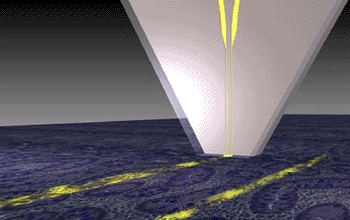Microfluidic Silicon Probe Accurately Stains Tissue Sections
By LabMedica International staff writers
Posted on 24 Jan 2012
A flexible, noncontact microfluidic probe made from silicon can help pathologists to investigate critical tissue samples for disease diagnostics.Posted on 24 Jan 2012
The microfluidic probe can accurately stain tissue sections at the micrometer scale. It consists of a silicon microfluidic head having two microchannels. Unlike an inkjet printer cartridge, the head reaspirates the liquid that it injects on a surface. This prevents spreading and accumulation of the liquid on the surface, which can lead to overexposure.

Image: The probe consists of a silicon microfluidic head having two microchannels. Unlike an inkjet printer cartridge, the head reaspirates the liquid that it injects on a surface. This prevents spreading and accumulation of the liquid on the surface, which can lead to overexposure (Photo courtesy of IBM).
Specifically for tissue section analysis, the probe can deliver an antibody very locally in a selected area of a tissue section with pinpoint accuracy. Since analysis can be done on spots and lines instead of on the entire tissue section, the tissue is better preserved for additional tests, if required. In addition, only a few picoliters of liquid containing antibodies are needed for each analysis spot.
IBM (Zurich, Switzerland) scientists developed the microfluidic probe, which fits to standard workflows in conventional pathology. In addition, it is compatible with current biochemical staining systems and resistant to a broad range of chemicals. The small size of the probe also enables easy viewing of the sample from above and below by the inverted microscope commonly used in clinical laboratories.
"We have developed a proof-of-concept technology, which I hope puts pathology on a modern roadmap—benefiting from the latest developments in silicon-based microfluidics," said Govind Kaigala, a scientist at IBM Research-Zurich. He added, "This new approach will enable pathologists to stain tissue samples with micrometer precision and easily perform multiple tissue stains on limited samples."
IBM scientists will continue to test and improve the microfluidic probe and potentially begin using it in laboratory environments in the next several months. In addition, the team plans to explore specific clinical applications, possibly with partners in the field of pathology. The microfluidic probe promises to support the work of pathologists and become a tool of choice for pharmaceutical research and diagnostics involving biological specimens.
Related Links:
IBM Research, Zurich













